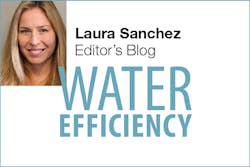“The way we treat stormwater, especially in California, is broken,” explains Joseph Charbonnet, a graduate student in civil and environmental engineering at UC Berkeley. “We think of it as a pollutant, but we should be thinking about it as a solution.”
As water flows through urban areas, over rooftops, lawns, and streets, it can accumulate organic matter, herbicides, pesticides, toxic metals, and oils. Municipalities often discharge this polluted water into neighboring rivers and streams, when in drought-affected areas, treated stormwater could be used to recharge aquifers and stored for later use.
Charbonnet and a team of researchers have developed a fascinating, low-cost method to remove contamination so that stormwater can safely replenish groundwater sources. Their findings were published last week in Environmental Science & Technology.
The method uses sand coated with manganese oxide to eliminate organic pollutants such as herbicides, pesticides, and the endocrine-disrupting bisphenol-A (BPA). The mineral binds to the organic chemicals so that they may be removed or broken down. Although the coated sand doesn’t remove all types of contaminants, researchers explain that it may be used along with other treatment techniques.
“As utilities in water stressed regions try to figure out how to get urban stormwater back into the ground, the issue of water quality has become a major concern,” explains David Sedlak, professor of civil and environmental engineering at UC Berkeley and the group’s adviser. “Our coated sands represent an inexpensive, new approach that can remove many of the contaminants that pose risks to groundwater systems where stormwater is being infiltrated.”
Researchers tested the technique by allowing a simulated stormwater solution with low concentrations of BPA to pass through the material. The manganese oxide-coated sand removed the BPA, but team members noticed that its effectiveness waned over time. They subsequently determined that the manganese oxide can be fully restored by flooding the sand with a chlorine solution.
Charbonnet and Sedlak are currently implementing the stormwater infiltration method in a 46-acre area in the Sun Valley neighborhood of Los Angeles, CA.
What are your impressions? Do you think that this method will effectively support water reuse and groundwater recharge efforts?
Our colleagues at WaterSmart Software are conducting a smart technology survey to inform a 2018 report. Water utility operations are increasingly reliant on ‘smart’ technologies that support the utility-customer relationship. The goal of this survey is to capture a snapshot of the water industry’s progress towards the ‘smart’ utility, and offer a benchmark for utilities looking to make the transition. Participants will receive a copy of the aggregate results and be entered to win $250 for a water charity of their choice. https://www.surveymonkey.com/r/9X8RBQ9
